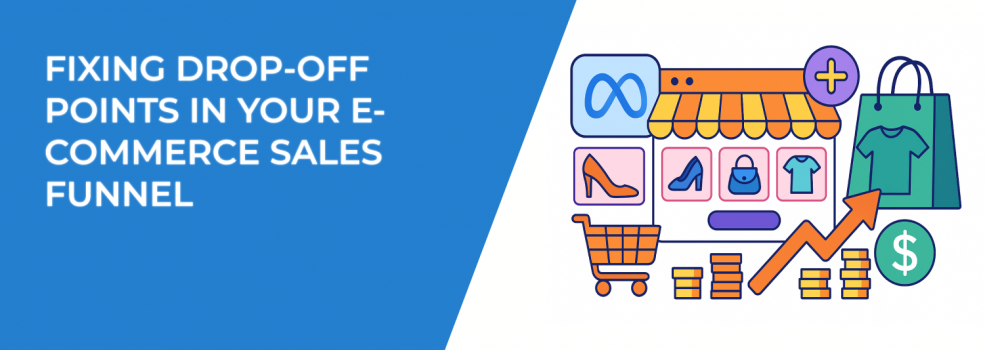Fixing Drop-Off Points in Your E-Commerce Sales Funnel
Running an e-commerce business means dealing with one big challenge: getting customers to make a purchase. But what happens when they don’t? If you’re noticing that people are leaving your site without buying, you might be dealing with drop-off points in your sales funnel.
In simple terms, a sales funnel is the journey your customers go through before making a purchase. If they bail at any stage, you lose out on sales. So, how can you stop that from happening? Let’s look at some common drop-off points and simple steps you can take to fix them.
1. What Is the E-Commerce Sales Funnel?
Think of your sales funnel as a series of steps. At the top, people learn about your brand. As they move down, they get more interested and finally, they make a purchase. But what happens when people just vanish before completing their purchase? That’s where drop-off points come in. Finding and fixing them can help you keep more customers in your funnel.
2. Finding Where Customers Are Dropping Off
To fix drop-off points, first, you need to know where they’re happening. If you’re using tools like Google Analytics, you can see where customers are leaving your site. Some common places to look for drop-offs include:
-
Homepage: if your homepage isn’t engaging or clear enough, people might leave right away.
-
Product pages: if people show interest in a product but leave without buying, something’s going wrong on the product page.
-
Checkout: a long or confusing checkout process often makes people abandon their cart.
-
Payment page: if the payment options seem sketchy or limited, it could scare customers off.
Once you’ve identified where customers are leaving, you can dig deeper into each stage to figure out what’s causing the problem. Is the homepage too cluttered? Are product descriptions lacking? Is the checkout process too long? Understanding the “why” behind the drop-offs is key to fixing the problem.
3. Fixing Product Pages
Your product pages are key to getting people to buy. Here’s how to make them better:
-
Clear descriptions: people need to know exactly what they’re getting. Provide detailed descriptions, high-quality images, and any other helpful info, like size charts.
-
Transparent pricing: hidden costs, like surprise shipping fees, are a huge turnoff. Make sure all costs are clear from the start.
-
Easy-to-find call to action: don’t make it hard for people to add things to their cart. Make that “Add to Cart” button easy to find and clickable.
A well-optimized product page can make all the difference. When visitors feel confident in what they’re purchasing, they’re more likely to move forward in the funnel. Make sure your product pages are visually appealing and user-friendly to create a smooth transition from interest to purchase.
4. Simplifying the Checkout Process
A complicated checkout is one of the biggest reasons people don’t finish their purchases. Here’s how to simplify it:
-
Offer guest checkout: let people buy without making them create an account. Some people just want to get in and out fast.
-
Autofill information: make it easier by autofilling details where you can, especially on mobile devices.
-
Show progress: people like to know how far along they are in the checkout process. Add a progress bar to show them the steps left.
The key to a great checkout experience is simplicity. Don’t overcomplicate things with unnecessary steps or forms. The easier and quicker the process, the more likely it is that customers will follow through and complete their purchase. A streamlined checkout is one of the most effective ways to reduce drop-offs.
5. Building Trust with Secure Payment Options
People need to feel safe when paying online. If they don’t trust your site, they won’t buy. To fix this:
-
Offer well-known payment methods: let customers pay with trusted services like PayPal, Apple Pay, or credit cards.
-
Show security badges: display security badges on your checkout page. This helps build trust and shows customers that their data is safe.
The payment process can make or break a sale. If customers feel like their information isn’t secure, they’ll leave without completing the transaction. Offering familiar, secure payment methods and showing trust signals like SSL certificates can reassure customers and encourage them to move forward.
6. Retargeting to Bring Back Lost Customers
Sometimes, no matter how smooth your funnel is, people will still abandon their carts. Retargeting is a great way to remind them about what they left behind.
-
Send reminder emails: if someone leaves items in their cart, send them a friendly email reminding them to complete their purchase. Offer a discount or free shipping to sweeten the deal.
-
Use retargeting ads: show ads to people who’ve visited your site but didn’t buy. These ads can bring them back to complete the purchase.
Don’t let abandoned carts go to waste. Retargeting allows you to reconnect with potential customers and remind them why they were interested in your products. A little nudge can go a long way in recovering lost sales.
For a deeper dive into retargeting strategies, you can explore this guide on Retargeting on Facebook: How to Win Back Abandoned Carts.
7. Continuously Test and Improve
Fixing drop-off points isn’t a one-and-done job. It’s an ongoing process. Regularly check your funnel to spot any new drop-off points, and make adjustments.
-
A/B test your buttons: try different wording or designs for your “Add to Cart” buttons to see what works best.
-
Look at exit pages: see which pages people leave from. If it’s a product page or checkout, tweak the layout or the flow to make it smoother.
The key to long-term success is to continuously optimize your funnel. Keep testing new strategies and making adjustments based on customer feedback and behavior. The more you refine the funnel, the better your results will be.
If you're looking for specific tips on improving the effectiveness of each stage in your funnel, Funnel Drop-Off Fixes: How to Improve Each Stage with Facebook Ad Data provides actionable insights.
8. Offering Great Customer Support
Sometimes customers abandon carts because they have questions or concerns. Make sure they can easily reach out for help.
-
Live chat: offering live chat can quickly answer questions and resolve issues that might cause customers to leave.
-
Clear FAQs: if customers can’t find answers to their questions, they might get frustrated and leave. Make sure your FAQ section is easy to find and covers common issues.
When customers know they can get support quickly, it boosts their confidence in purchasing. Offering real-time help can solve problems immediately and prevent cart abandonment, keeping customers on track to complete their purchase.
Wrap-Up: Keep Improving
Fixing drop-off points is all about paying attention to where your customers are getting stuck and making things easier for them. By improving product pages, simplifying checkout, offering secure payment options, and using retargeting ads, you can reduce cart abandonment and boost sales.
And remember, fixing drop-offs isn’t something you do once and forget. Continuously test, tweak, and improve your funnel to keep those customers coming through. Stay proactive, and watch your sales grow!
For further insights into how to optimize your funnel and improve conversions, take a look at the article Facebook Ads Funnel Strategy: From Audience Identification to Conversion.

